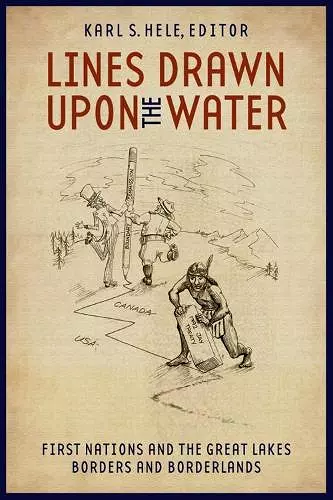Lines Drawn upon the Water
First Nations and the Great Lakes Borders and Borderlands
Format:Hardback
Publisher:Wilfrid Laurier University Press
Published:30th Sep '08
Currently unavailable, our supplier has not provided us a restock date

The First Nations who have lived in the Great Lakes watershed have been strongly influenced by the imposition of colonial and national boundaries there. The essays in Lines Drawn upon the Water examine the impact of the Canadian - American border on communities, with reference to national efforts to enforce the boundary and the determination of local groups to pursue their interests and define themselves. Although both governments regard the border as clearly defined, local communities continue to contest the artificial divisions imposed by the international boundary and define spatial and human relationships in the borderlands in their own terms.
The debate is often cast in terms of Canada's failure to recognize the 1794 Jay Treaty's confirmation of Native rights to transport goods into Canada, but ultimately the issue concerns the larger struggle of First Nations to force recognition of their people's rights to move freely across the border in search of economic and social independence.
``Lines Drawn upon the Water thus works to nuance understandings of Great Lakes colonial history and to problematize the boundaries between Canadian and American, settler and native, and colonizer and colonized.'' -- Keavy Martin -- Canadian Literature, 203, Winter 2009, 201003
``Lines Drawn upon the Water is a useful read for anyone concerned with North American borderlands, issues of Native identity and sovereignty, or Great Lakes history. Although most of the material is oriented on the Upper Lakes, these essays raise issues that are not bound by this geography. As the number of young scholars included in this work proves, studies of the US-Canadian border will continue to provoke interest and attention for years to come.'' -- Daniel P. Glenn, Washburn University -- Canadian Journal of History, XLIV, Autumn 2009, 200912
``The book is a masterful collection of articles that stretches one's concept of borders far beyond the restrictions conjured by notions of geography. Each chapter has the potential to invite further study of individual situations where the interaction of divergent cultures provides a microcosm with wide-ranging implications.'' -- David J. Norton, King's University College, London, Ontario -- Canadian Journal of Native Studies, Vol. 29 #9 1 and 2, 2009, 200912
``The essays draw upon specific academic disciplines--history, anthropology, environmental studies, and literature--that hew remarkably ot the book's theme.... The thematic coherence of the volume provides an important window into the interaction of native peoples and white social and policial institutions. Because of their geographic focus, ironically, htey are able to demonstrate the larger lesson: that to understand the meaning of borders, one must see beyond the lines drawn upon the water.'' -- Jonathan M. Chu, University of Massachusetts -- The Historian, Volume 72, #4, 201103
``The essays successfully fulfill the objective set out in the introduction, which was to deconstruct the perception of the Great Lakes borderland as a clear-cut international division. Considering the collection's multidisciplinary focus, each author's historical interpretation is woven into their specialized area, effectively making for a thought-provoking read.... Not only does [the volume] serve as an excellent collection of essays concerning the borderland experiences of the First Nations people in the Great Lakes region, its collective argument sets a standard for all future native borderland studies.'' -- Allan Downey -- H-AmIndian, H-Net Reviews, January 2010, 201003
``The book is a masterful collection of articles that stretches one's concept of borders far beyond the restrictions conjured by notions of geography. Each chapter has the potential to invite further study of individual situations where the interaction of divergent cultures provides a microcosm with wide-ranging implications.'' -- David J. Norton, King's University College, London, Ontario -- Canadian Journal of Native Studies, Vol. 29 #9 1 and 2, 2009
ISBN: 9781554580040
Dimensions: 229mm x 152mm x 25mm
Weight: 700g
378 pages